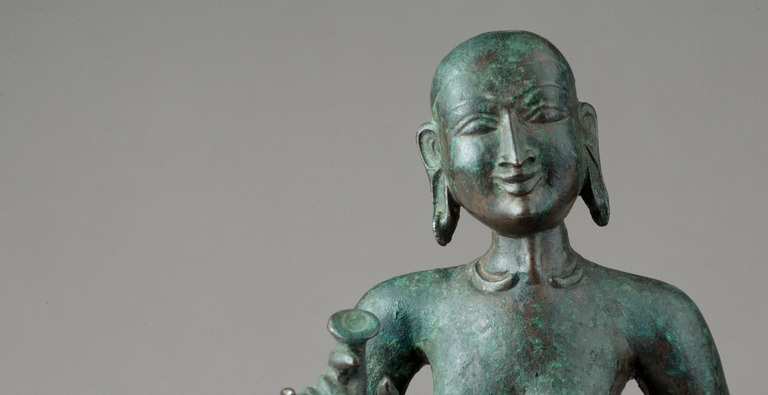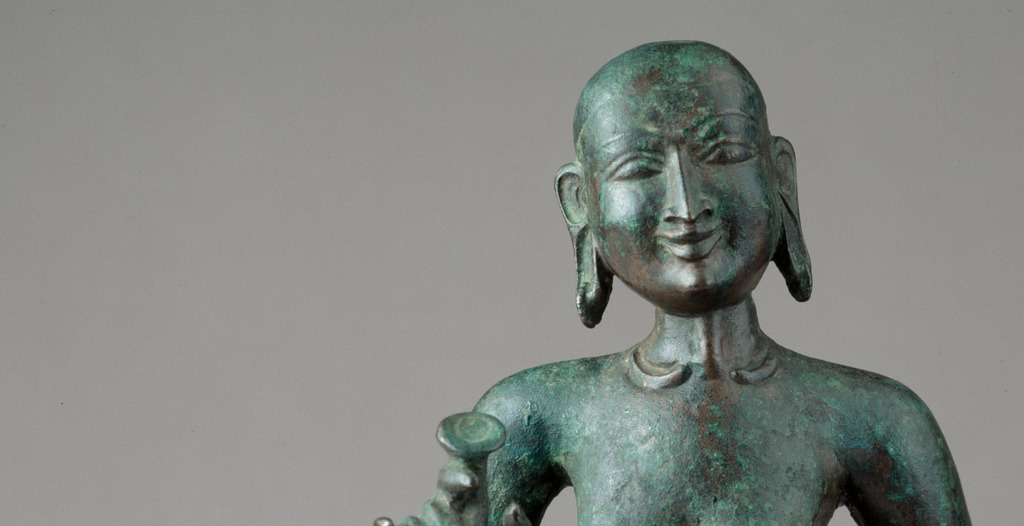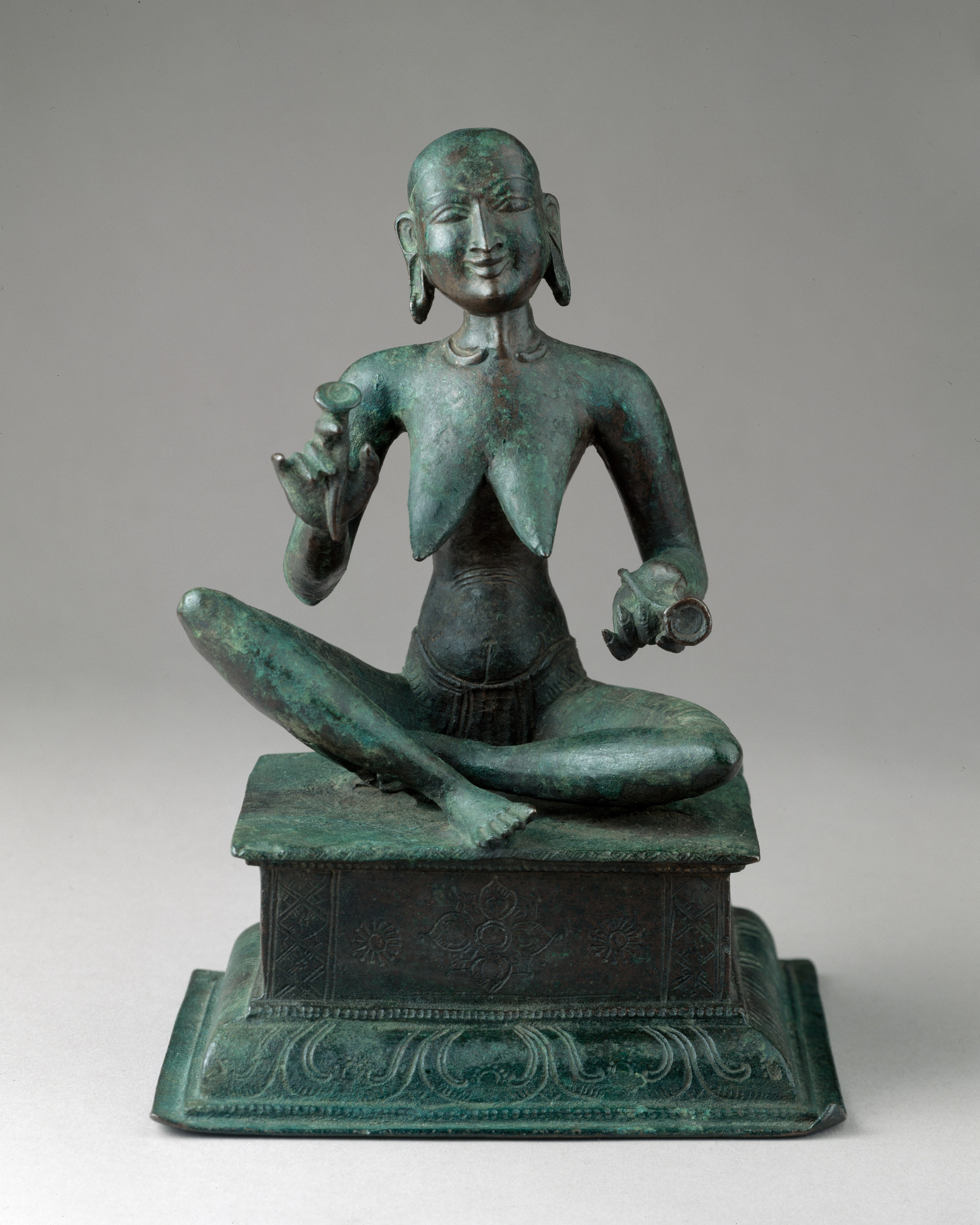Birth
c. sixth century ce, port town of Karaikkal in modern-day Tamil Nadu, India
Education
Her work exhibits profound knowledge in at least three disparate traditions, viz., the Tamil prosodic, the Sanskrit puranic and the extant music and dance traditions of her region.
Death
Unknown. According to oral tradition, she is still singing to Lord Shiva within a sealed section of the Rathinasabai (Hall of Gems) of the Sri Vada Aranyeswarar Temple in Thiruvalangadu, Tamil Nadu, India.
Religion
Shaivism (Hinduism)Karaikkal Ammaiyar was a South Indian Shaiva poet saint.
Three works of poetry are attributed to Karaikkal Ammaiyar: Thiruvalangattu Thiruppathigam, Arputhatthiruvanthathi, and Thiruirattai Manimalai. She was a devotee of Lord Shiva, and her works are identified as the earliest in the Tamil Shaiva bhakti canon. Her contribution to religious literature is in bringing together the mode of representing the inner world, a feature of the secular parts of the Tamil Sangam corpus, and the didactic mode within the Sramana traditions, exemplified in the Tirukkural, and foregrounded the discipline of worship as a servant who is in a special relationship with Shiva.
Personal Information
Name(s)
- Karaikkal Ammaiyar (literally, ‘Revered Mother from Karaikkal’; the poet is popularly known today with this name.)
- Karaikkal Pey (literally, ‘the ghoul of Karaikkal’; this is how the author identifies herself in the signature verse to two of three compositions attributed to her. Including a signature verse at the end of their composition became a convention in Bhakti poetry following Karaikkal Pey)
- Peyar (the later Nayanmar saint Cuntarar [c. 8th century ce] identifies her with this name)
- Karaikkarpeyar (medieval commentaries by Naccinarkkiniyar [c. 10th century ce] and Amirtacakarar [c. 11th century ce] on the ancient Tamil grammatical work Tolkappiyam identify her compositions with this name.)
- Punithavathy (the birth name attributed to her by her 12th-century biographer/hagiographer Sekkizhar)
Date and place of birth
- sixth century ce, port town of Karaikkal in modern-day Tamil Nadu, India.
Date and place of death
Unknown. According to oral tradition, she is still singing to Lord Shiva within a sealed section of the Rathinasabai (Hall of Gems) of the Sri Vada Aranyeswarar Temple in Thiruvalangadu, Tamil Nadu, India.
Family
There are no references to Karaikkal Ammaiyar’s ancestry in her own works. Our knowledge of Karaikkal Ammaiyar’s family life is entirely from the Periyapuranam, a Tamil poetry account which was written by Sekkizhar at least six centuries after her time. Also known as Tiruttondarpuranam, the Periyapuranam is a Tamil poetic account of the lives and works of the 63 Nayanmar saints of the Tamil Siva bhakti canon. According to this work, she was named Punithavathy at birth and grew up in a closely-knit community of prosperous merchants in the town of Karaikkal. Sekkizhar also mentions that she grew amidst affection from her relatives, indicating the presence of a large natal family cohabiting in the same house or locality. This community is often identified with the predominantly mercantile Chettiar caste in contemporary times.
Mother
Unknown
Father
Dhanathattan, identified by Sekkizhar as the head of a group of seafaring merchants.
Marriage and Family Life
According to Sekkizhar, Punithavathy was married to Paramadhattan, son of a famous merchant called Nitipati from Nagapattinam, as per established custom. The marriage was solemnized according to tradition in Karaikkal and, since she was his only child, Dhanathattan built a home for the newly wed in Karaikkal so they may stay close to him. Paramadhattan’s wealth increased in this period, and Punithavathy kept her house in strict discipline while her love for Shiva increased. As per tradition, she fed all devotees of Shiva when they visited her house and also gave offerings of wealth or clothing as they required. The couple did not have any children, and Sekkizhar’s hagiography does not mention any other important woman in her life, not even the name of her mother.
Education
Her work exhibits profound knowledge in at least three disparate traditions, viz., the Tamil prosodic, the Sanskrit puranic and the extant music and dance traditions of her region. Details of how she gained knowledge of these is not known, however some conjectures can be made. The historical juncture at which she begins to write was marked by the decline of the Kalabhras, who patronized the Sramana religions (e.g. Buddhism, Jainism), and the ascendancy of the Pallavas, who were Hindus and used Sanskrit in addition to Tamil and Prakrit, and patronized Brahmins and donated lands for construction and upkeep of temples. A part of her corpus celebrates the dancing Shiva, and here she makes mention of a number of musical instruments to keep rhythm and a number of moves that the deity performs. Epigraphist Padmavathi Anaiappan has drawn our attention to the presence of a long-forgotten ragam bearing the name of Thiruvalangadu, where Karaikkal Ammaiyar is believed to have witnessed and sang for (and continues to witness and sing for) the dancing Shiva. The Periyapuranam mentions that she went on a pilgrimage to Kailash, the abode of Shiva, and met him there; this could read as a documentation of narratives drawn from her travel beyond the southern lands and into the Gangetic plains. Therefore, the rupture seen with the shift of patronage to Shaivism at the political centre of power and the concomitant influx of religious discourses, the rich repertoire of performing traditions in the place where she is believed to have sung her works, and her experience of travel and encounter in the heartland of the puranic tradition may explain her education. The Tamil literary tradition had seen women poets before her, and therefore it is unsurprising that a wealthy woman of her stature is literate and conversant with the established literary convention.
Religion
Karaikkal Ammaiyar was a devotee of Lord Shiva, and her works are identified as the earliest in the Tamil Shaiva bhakti canon. Her contribution to religious literature is in bringing together the mode of representing the inner world, a feature of the secular parts of the Tamil Sangam corpus, and the didactic mode within the Sramana traditions, exemplified in the Tirukkural, and foregrounded the discipline of worship as a servant who is in a special relationship with Shiva. In her case, she saw herself as one of the ghouls ministering to the needs of the frenzied dancing deity. Drawing on internal evidence from her poetry, Sekkizhar paints a picture of her as someone steeped in devotion to Shiva from childhood. However, Padmavathi Anaiappan urges us to look beyond that particular verse which is seen to affirm her prodigious inclination to devotion and points to the religious affiliations of the sea-faring Tamil mercantile communities of the time. She argues that she may have been raised in a Buddhist household in childhood and was converted into Shaivism, particularly the now-extinct non-Vedic Tantric Kapalika school. The Kapalika ascetics are said to have smeared their bodies with ashes, wore their hair long and matted, carried a human skull as a begging bowl from which they ate, and engaged in ritualistic sacrifice that involved meat, blood and at times even humans. Karaikkal Ammaiyar’s poetry is particularly elaborate in its depiction of the cremation ground as the site of Shiva’s dance, and contain evocative descriptions of ghouls feasting on corpses.
Her work exhibits profound knowledge in at least three disparate traditions, viz., the Tamil prosodic, the Sanskrit puranic and the extant music and dance traditions of her region.
Transformation(s)
One morning a group of travellers meet Paramadhattan and present him with two mangoes, which he promptly sends home to Punithavathy. A mendicant devotee of Shiva enters Punithavathy’s house and she prepares to serve him food. While rice had been cooked by then, the vegetable accompaniments weren’t done. So, she serves him rice and one of the two mangoes. When Paramdhattan returns home for lunch he relishes a mango and asks for the other one. Unable to admit that she doesn’t have it anymore, she goes into a room and implores Shiva to give her a mango. When Paramadhattan eats this mango, he is sure that this is not the same mango he had sent home owing to its superior taste and asks her how she got it. She tells him what happened. Paramadhattan asks her to ask Shiva for another mango (A. S. Gnanasambandan argues that this could indicate Paramadhattan doubting her chastity), and she does so. Upon seeing the third mango, Paramadhattan is shocked at the divinity of his wife and, under the pretext of sailing away for trade, he separates from her. Paramadhattan settles in a southern kingdom, remarries and has a daughter who he names after his first wife. Punithavathy’s relatives hear of Paramadhattan’s whereabouts and prepare to take her to him. Before Punithavathy and her family could reach his place, Paramadhattan takes his wife and his daughter to them, prostrates before Punithavathy and announces to his marital family that Punithavathy is divine and not human. Upon hearing this, Punithavathy asks Shiva to turn her into a ghoulish figure because she had cared for beauty and youth only to satisfy her husband. She is immediately transformed and everyone is frightened. She then proceeds northward to reach Kailasa, the abode of Shiva. Upon reaching the foothills of the mountain she begins walking on her head as she feels that walking on her feet would pollute the sacred place. At Kailasa, Shiva receives Punithavathy as his ‘Ammai’, i.e. mother, and asks what she seeks. She asks for everlasting love for him within her, to never take rebirth, and if it so happens that she has to be reborn, to never forget him. She also wishes to be able to sing for him whenever he dances. Shiva grants her these wishes and instructs her to proceed to Thiruvalangadu, where she will be able to witness his cosmic dance and sing for him in perpetuity. She reaches Thiruvalangadu and continues to sing for the dancing Shiva till date.
Contemporaneous Network(s)
We cannot be sure of the networks that Karaikkal Ammaiyar was part of during her time, although as mentioned earlier she may have been part of a network of Kapalika mendicants. However, she has been mobilized by networks of feminist scholars of contemporary South Asia for models that have challenged hetero-patriarchal norms in ancient and medieval India.
less
Significance
Works/Agency
Three works of poetry are attributed to Karaikkal Ammaiyar: Thiruvalangattu Thiruppathigam (‘Sacred Decade of Verses on Thiruvalangadu’; there are two such decades and in total comprise 22 verses, i.e. ten each and one signature verse for each decade), Arputhatthiruvanthathi (‘Sacred Linked Verses on Wonder’; a collection of 100 verses and one signature verse) and Thiruirattai Manimalai (‘Sacred Twin Garland of Gems’; a collection of 20 verses). It is believed that Karaikkal Ammaiyar wrote the Arputhatthiruvanthathi and Thiruirattai Manimalai before her pilgrimage to Kailasa and the Thiruvalangattu Thiruppathigam upon witnessing Shiva at Thiruvalangadu. Nambiyandar Nambi compiled the works of the Nayanmars, including those of Karaikkal Ammaiyar, under the patronage and request of Rajaraja Chola I in the 11th century ce. Nambi collected extant manuscripts, and arranged them into eleven volumes and called it the Tirumurai. Sekkizhar’s Periyapuranam was then added to this corpus and this twelve-volume compendium has come to be the Tamil Shaiva canon. Karaikkal Ammaiyar’s poetry is part of the eleventh volume of the Tirumurai.
Reputation
In popular Tamil imagining, Karaikkal Ammaiyar’s story is as important as her poetry, if not more. A temple in Karaikkal is dedicated to her and she is venerated here as Punithavathy. Also, since there are no narratives within the Shaivite literature that identifies any parentage for Shiva, it is crucial that Shiva addresses her as his mother in Kailasa. In her poetry, there are references to people being fearful of her because she is a ghoul and she is part of the band of ghouls, even if they are attending to Shiva. As for her works themselves, she is acknowledged as being the first in the tradition of Bhakti writing on Shiva by the later Nayanmars. At times, they use her poetry as invocatory stanzas to begin their works, and her inclusion in the Shaiva canon is evidence of a favourable reception for her work throughout the fourteen centuries since she wrote. However, in terms of the liturgical use, the first few volumes of the Tirumurai are popularly used across Tamil Shaivite temples, but of her works only the Arputhathiruvanthati is recited in the temple dedicated to her at Karaikkal. The decline and subsequent extinction of the Kapalika school of Shaivism may have contributed to the decline in importance attributed to her works.
Legacy and Influence
Karaikkal Ammaiyar’s poetry has been acknowledged for breaking new ground in literary convention. The form of her verses (pathigam) came to be taken up by later Nayanmar poets to model their compositions. She wrote in the classical venpa meter, but also likely introduced the meter known as kattalai kalithurai through the Thiruirattai Manimalai, wherein a verse with the venpa meter was followed by a verse in the kattalai kalithurai meter. This technique of alternating meters, akin to braiding a plait, would develop to great heights in the coming centuries. Her work also probably initiated large-scale borrowings from Sanskrit terminology and thereby marks a distinct departure from the Sangam tradition where even if themes and stories from non-Tamil lands were borrowed the scale and extent of lexical borrowings was limited. In terms of the content of her work, she is said to have initiated the practice of asking questions of god directly.
Gnanasambandan notes that the popular c. 5th–8th century Tamil epic Silappathigaram could be seen as a literary assault on the stature of Karaikkal Ammaiyar because of its attention to karpu (chastity), and argues that the epic expanded and gave political and social force to the chastity of a woman that was more inward-oriented in the case of Karaikkal Ammaiyar. This, he believes, could have contributed to the decline in the recall, when speaking about karpu, of Karaikkal Ammaiyar’s story in favour of the much celebrated and commemorated story of Kannagi in Silappathigaram. However, Elaine Craddock believes that the forging of a secular Tamil regional identity, across political boundaries, that the Silappathigaram had achieved was soon displaced by the consolidated Shaiva bhakti Tamil identity carved out by the tradition begun by Karaikkal Ammaiyar.
The temple dedicated to her annually commemorates the mango incident in her life through the mangani thiruvizha (festival of the mango fruit), in which Sekkizhar’s story of Karaikkal Ammaiyar’s life is restaged and visitors to the festival are presented with mangoes by the inhabitants of the town.
Two schools have been established in her name in Karaikkal: the state-funded but private-run Karaikal Ammaiyar High School and the entirely private-administered Karaikal Ammaiyar Higher Secondary School.
In 2019, the Tamil Nadu state government’s Ministry of Tamil Official Language and Tamil Culture announced instituting a set of awards in the names of various Tamil writers, and one of those awards is given in the name of Karaikkal Ammaiyar. The Karaikkal Ammaiyar Award for 2020 was awarded to Tamil Professor Dr Gnanapoongothai.
less
Controversies
Controversy
While Sekkizhar’s hagiography is believed to have been based on extensive field work of oral history sources and literary research, it is also possible that the imperial Chola state was invested in building a coherent narrative of tradition that could claim semblance of continuity in the service of an aggressively militaristic, exceptionally well-governed and expanding political strategy. This view sits comfortably alongside her world-making of Shiva as the destroyer, surrounded by ghouls and in a perpetual state of frenzied dancing. Also, as Karen Pechilis argues, we cannot be definitively sure that Karaikkal Ammaiyar was in fact a woman. We can only be certain of the insistence of the poet ending two of her three compositions identifying herself as Karaikkal Pey. The idea that she is a woman gets firmly implanted in the Tamil imaginary with Nambi’s biography first and then the elaborate hagiography by Sekkizhar. They, and contemporary scholars, identify her gender with a verse-length description of a female ghoul in the first decade of the Thiruvalangadu Thiruppathigam.
New and Unfolding Information and/or Interpretations
Academic scholarship has viewed the emergence of Tamil Saiva bhakti literature as a political and social response to the pervasive influence of the Sramana sects, most importantly Jainism. Indira Viswanathan Peterson has argued that it was very effective strategy to place the Jains as a counterfoil for self-definition and the consolidation of power. There is also consensus that the Saiva Siddhanta, the theological philosophy of Shiva worship in Tamil lands, was evolving at the time, and Karaikkal Ammaiyar’s works shadow what would emerge as a sophisticated and dominant ritual and belief system in the following centuries. The Bhakti poets are also seen as talking back to Brahmanical authority that derived its power and efficacy from the post-Vedic traditions. Karaikkal Ammaiyar’s poetry, which started the tradition of writing about speaking to Shiva without the need for an intermediary, is viewed as a powerful critique of Brahmin authority.
less
Bibliography
Primary (selected):
Ammaiyar, Karaikkal. 1935. Karaikkal Ammaiyar Thirumurai. Tanjore: Kooturavu Minniyakkap Pathippagam.
Chakravarty, Uma. 1989. ‘The World of the Bhaktin in South Indian Traditions—The Body and Beyond’, Manushi 50-51-52.
Craddock, Elaine. 2010. Siva’s Demon Devotee. New York: SUNY Press.
Pechilis, Karen. 2012. Interpreting Devotion. London: Routledge.
Peterson, Indira Viswanathan. 1989. Poems to Siva. Princeton, NJ: Princeton University Press.
Ramaswamy, Vijaya. 1992. ‘Rebels — Conformists? Women Saints in Medieval South India’. Anthropos 87.
Web Resources (selected):
Anaiappan, Padmavathi. 2018. 'Karaikkal Ammaiyar', lecture uploaded on YouTube at https://www.youtube.com/watch?v=grWvzOf_DCc (last accessed 25 July 2021)
Gnanasambandan, A. S. 2018. 'Lecture By Aa Saa Gnansambandan Aiya', uploaded on YouTube at https://www.youtube.com/watch?v=z9tM-QyUkv0 (last accessed 25 July 2021)
Kalaichelvan, Madhusudhanan. 2018. 'Madhuradhwani: Talk on Karaikal Ammaiyar' lecture uploaded on YouTube at: https://www.youtube.com/watch?v=bHy3O-oN-5k (last accessed 25 July 2021).




Comment
Your message was sent successfully